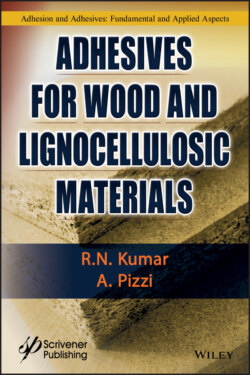Читать книгу Adhesives for Wood and Lignocellulosic Materials - R. N. Kumar - Страница 66
2.14 Effect of Surface Roughness on Contact Angle
ОглавлениеThe above equation is true for smooth, contamination-free surface. However, the real solid surface is not smooth and the roughness of the surface has a profound effect on the wetting and adhesion. The innumerable small hills, valleys, and crevices on the solid surface entrap and occlude air or vapor within them. Even if θ = 0, it is not possible under real conditions to ensure that an intimate contact between the adhesive and adherend is established. Surface roughness plays therefore an important role in the wettability of a solid surface.
The impact of roughness on the contact angle is given by the Wenzel equation (Equation 2.12)
(2.12)
The Wenzel equation (Equation 2.12) relates the contact angle θw of a liquid measured on a rough surface having a roughness ratio, r, with the contact angle of the same liquid measured on a smooth surface, θY. The roughness ratio is the ratio of the true surface area of a rough surface to the surface area of the smooth surface. This ratio r will always be larger than one. Wenzel’s relation also shows that surface roughness will decrease the contact angle for a water droplet on a hydrophilic surface or increase the contact angle for a water droplet on a hydrophobic surface.
The advancing and receding contact angles can throw light on the magnitude of roughness of the wood surface. The difference between advancing and receding contact angles is the contact angle hysteresis. The magnitude of contact angle hysteresis is dependent on roughness, topography, morphology, and chemical homogeneity of the solid surface [31]. Good [34] suggested that the advancing contact angle represents hydrophobic areas on the surface, while the receding contact angle characterizes hydrophilic areas.
